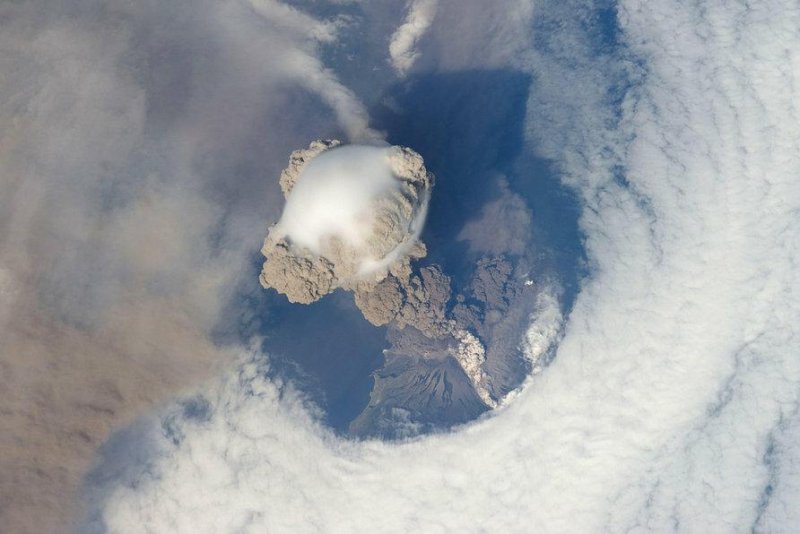Astronauts on the space station photographed the eruption of Russia's Sarychev Peak in 2009. Photo by NASA
Jan. 29 (UPI) -- Until now, scientists thought extratropical volcanoes had a limited impact on Earth's climate. But new research suggests volcanoes far from the equator can trigger significant cooling patterns.
When volcanoes erupt, they often eject large amounts of gas and particulate matter into the atmosphere. The ejecta can alter atmospheric dynamics and block the solar radiation, causing a cooling effect -- a process called climatic forcing.
In 1991, the eruption of Mount Pinatubo in the Philippines cooled Earth's average global temperature by 0.5 degrees Celsius. But recent eruptions outside the tropics -- Kasatochi in Alaska in 2008 and Sarychev Peak in Russia in 2009 -- have had a less pronounced effect on Earth's climate.
New analysis of historic volcanic eruptions suggest Kasatochi and Sarychev Peak were exceptions, not the rule. Extratropical volcanoes can trigger dramatic climatic forcing.
"Our investigations show that many extratropical volcanic eruptions in the past 1,250 years have caused pronounced surface cooling over the Northern Hemisphere, and in fact, extratropical eruptions are actually more efficient than tropical eruptions in terms of the amount of hemispheric cooling in relation to the amount of sulfur emitted by the eruptions," Matthew Toohey, climate scientist at the Helmholtz Association of German Research Centers, said in a news release.
When volcanoes release sulfur into the atmosphere, the gas creates an aerosol haze in the stratosphere. The layer of suspended particles can spread out and remain for months or even years. Slowly the aerosol layer travels away from the equator, eventually dissipating around the mid or high latitudes.
Because extratropical volcanoes release sulfur directly into the mid to high latitudes, scientists assumed their aerosol hazes have a shorter shelf life. Recent eruptions fit the theory, but in addition to being farther from the poles, Kasatochi and Sarychev Peak were also significantly smaller than Pinatubo.
For better comparisons, scientists analyzed ice cores to find larger historic eruptions and tree rings to measure the effects of said eruptions on global temperatures. Scientists used the data they collected to simulate large extratropical eruptions. Their models showed the gas and particles ejected by extratropical volcanoes have only a slightly shorter shelf life.
Researchers shared their findings this week in the journal Nature Geoscience.
"Injections into the lowermost extratropical stratosphere lead to short-lived aerosol, while those with stratospheric heights similar to Pinatubo and the other large tropical eruptions can lead to aerosol lifetimes roughly similar to the tropical eruptions," said Kirstin Krüger, researcher at the University of Oslo.
Though large extratropical volcanic eruptions are rarer than big tropical eruptions, they can have nearly as great of an impact on the planet's climate.















